|
 Mammoth Hot Springs, Upper Terrace Loop - Yellowstone National Park
N 44° 57.926 W 110° 42.453
12T E 523063 N 4979152
One of the largest hot spring areas in Yellowstone National Park
Waymark Code: WMJWB
Location: Wyoming, United States
Date Posted: 07/31/2006
Views: 188
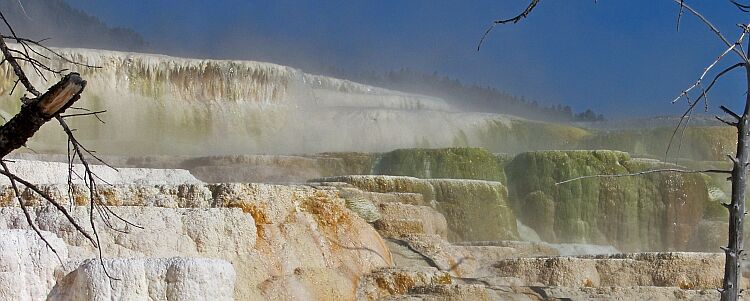
Heat, water, limestone, and rock fracture combine to create the terraces of the Mammoth Hot Springs area. The main mineral deposited here is travertine, usually a white rock; however the microorganisms and living bacteria create beautiful shades of oranges, pinks, yellows, greens, and browns. The Mammoth Hot springs are constantly changing. As formations grow, water is forced to flow in different directions. The constant changes in water and mineral deposits create a living sculpture.
|
Mammoth Hot Springs is divided into two sections, the Lower Terraces, and the Upper Terrace Loop.
Here is a picture of the entire area, taken from about a quarter mile away. Here you can read more about Mammoth Hot Springs at the National Park Website. |
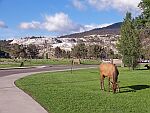
|
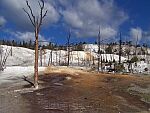 |
Angel Terrace, at the entrance to Upper Terrace Loop, is one of Mammoths most unpredictable features. For decades it was dry and crumbling, but since 1985, some of the hot springs have been intermittently active in parts of the formation. The dramatic presence of these features comes from abundant water, white formations and thermophiles that thrive in hot water.
For more pictures of Angel Terrace click here: 1, 2. |
New Blue Spring is located near a parking lot overlooking the Main Terrace. It is one of the best examples of the area’s dynamic character and shifts activities frequently. It can become active or inactive several times in one year. It began overflowing to the north in Summer 2000.
For more pictures of New Blue Spring click here: 1,
2,
3. |

|
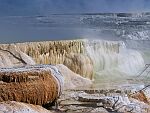 |
Canary Spring is the only spring in the area that cannot be seen from the convenience of your car but we strongly recommend the short walk. This bacteria infested spring radiates a glorious canary yellow and you’ll find flowing hot water and new travertine formations as you walk to the spring. In the 1800s, yellow filamentous bacteria were dominant at the spring. Yellow still remains common near the vent but the spring now also exhibits the orange, green and brown common to the rest of the area.
For more pictures of Canary Spring click here: 1,
2,
3,
4. |
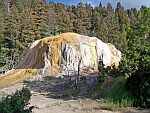 |
Orange Spring Mound is our personal favorite in the area. (If you come here early in the morning, you can enjoy this beauty in total solitude!). The spring flows slowly from several vents at its top. For thousands of years, calcium carbonate has worked on the mound and a certain kind of bacteria is responsible for the striking orange color.
For more pictures of Orange Spring Mound here: 1,
2,
3.
|
Temperature (F): 163

Temperature (C): 73

Type: Developed

Cost?: Use Fee

Open to the Public?: yes

Clothing Optional?: no

Other Amenities:
This is not a resort/hot tub kind of hot spring but a potentially dangerous geological active thermal area. To enjoy its beauty, stay on the boardwalks and obey the rules.

|
Visit Instructions:
1. Include a photo of the hot spring
2. Describe your visit.
|